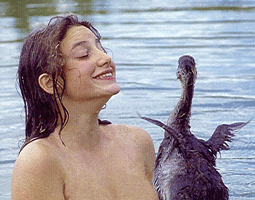
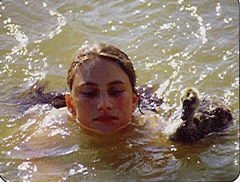
French geese
All the following are excerpts from the Books about the Farm Yard
d'Alsace -
blanche du Bourbonnais
-
de la Meuse
-
blanche du Poitou
- de Bresse
-
Flamande
-
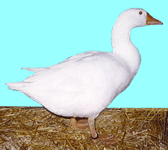
- Its origin lies in the small valleys of lower Alsace. Zorn, Bruche, Sauer, Moder, as well as
in the Ried plain. It is a small goose, mainly produced with a view to getting the largest possible
goose liver after force-feeding.
- Breeders have to look for and select animals which are short on their legs, with a body as wide
as possible, thus allowing for a good development of internal organs, in particular that of the liver.
Eggs for brooding weigh around 120 g . Male and female have the same weight : 4 to 4.5 kg. The Alsace
goose was created to produce very fatty livers after force-feeding.
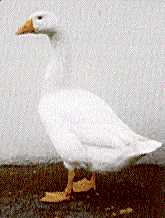
- As the name indicates, its origins lie in the Bourbonnais, which is in the department of l'Allier,
with Moulins in its center. It is a goose of good size, as the gander weighs 9 to 10 kg and the goose
7 to 8 kg. It is hardy, matures early and is rather prolific, active, massive, stocky but with no
heaviness, it has a slight paunch. A good egg producer, the goose will brood well if one leaves her
the eggs. These have a white shell and weigh 160 g . This breed is intended for the production of good
sized subjects for roasting, but it can be successfully used for fatting purposes. Only one variety is
recognized : the white with red-orangy bill going sometimes to rosy orange.
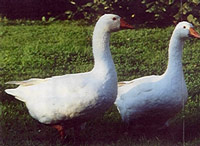
- The Bresse goose has never had any recorded standard - nor even a precise
description. Issue number 15 of the magazine La Vie à la Campagne (Life in the Country) states :
"The Bressan Goose does not exhibit clearly defined characteristics equalling for example that of
the Goose of the Poitou (region) or of the Bourbonnais. Barring a few exceptions, flocks do not give
a feeling of attaining suitable homogeneity standards. This goose gives us the impression of being of
average size, rather small, a lighter and jauntier model than the Bourbonnais Goose."
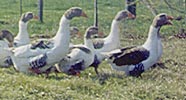
- Two colours : white ; grey and white.
- Gander : 5 to 6 kg ; goose : 4 to 4,5 kg.
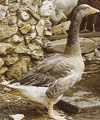
- This grey goose has been selected in the south-east of France, in the region of the Landes,
from the Toulouse Goose with the objective of getting a lighter animal for the production and quality
of foie gras. This has resulted in a gander weighing 7 kg and a goose of 6 with strong bodies and a
well developed belly
Top of the page
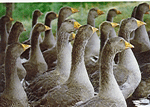
- The marshes of western Poitou have always been a region favorable to the breeding of geese.
They had freedom, space, water and greenery at will and many inhabitants of the Poiré-sur-Velluire had
their flocks on the communal grounds. Each household had the right to graze a "barrel" , that is to say
9 geese and 2 ganders and the goslings. After the Second World War there was at Poiré-sur-Velluire ,
for example, a communal ground of 494 acres and 15 goose breeders with a total livestock of 1400 ;
this represented a considerable source of income for the breeders who sold the flesh (roasting goose),
the feathers and the down. In 1992 in the same area there were only 2 breeders !
Also the interregional park of the Poitevin Marshes began as of 1992 a policy aiming at the preservation
of this population, collecting from breeders those individuals considered to be most representative.
A selection has been carried out in order to preserve those individuals corresponding to criteria set out.
As of 1996 the sale of breeding stock had begun and in 1998, the park had a population of 150 specimens
of homogenous quality within a reseve.
-
- It is a small grey goose, probably a direct descendant of the wild goose which was sometimes
kept in considerable flocks in the valleys of the river Meuse and its tributaries, in the North-East
and even in Belgium up to the border with the Low Countries. Bred since, at least, the 19th Century, it
doesn't exist any longer. One can however liken it to the alsatian goose.
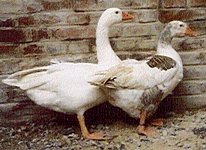
- Breed obtained by improving the common goose. It is caracterized by the goose and gander
being of different colors. . The gander is always white whereas the goose grey and white.
It is a middle sized goose (gander 4.5 to 5.5 kg, goose : 4 to 5 kg) , laying eggs of 120g.
Its body is massive but has elegance. Very rustic, easy to breed, it will be kept in large pastures
which will provide a large part of its food.
- Breeding of this white goose goes back a long way in the department of the Vienne and the bordering regions. Its breeding is said to have been introduced in Poitiers under the dukes of Aquitaine by some Dutch gentlemen who settled in that town. It is not a very large goose, (the gander weighs 6.5 kg, and the goose 6 kg) , the paunch is either absent or very discreet. Yellow-orangy bill marked with clearer groove tending towards rose, clear blue iris, yellow-orangy tarsus are its main characteristics.
It is bred for its flesh, feathers and down, like other geese, but also for its down garnished skin, sold under the name of "swan strips" or "swan skins".
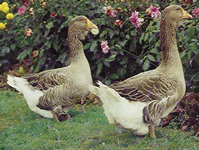
- As the name indicates, this breed originated in the south west of France, but to be perfectly honest it should be mentioned that its present shape is the work of English breeders.
It is an enormous bird, of thick and massive build has a proud stance a strong neck, wide and short head with dewlap, a double-closed paunch in the rear, touching the ground.
Its plumage is abundant, strong, tight in the superior areas of the body, but very thick looser and softer in the lower areas, puffed out on the thighs and rump.
The gander weighs 9 to 10 kg and the goose 8 to 9 kg . Eggs for brooding should weigh 160 g minimum.
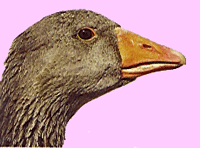
- A goose without dewlap, a little lighter, elegant shape, of lighter height and shape than the type with dewlap (gander : 8 to 10 kg , goose 6 to 8 kg). The volume does not exclude either slimness of build nor agility in movement. Its plumage is abundant, tight but less thick on the rump and the thighs than on the back and chest.
- This type with no dewlap is more productive than the preceeding type and is mainly raised for the preparation of foie gras in the southwest.
- To note :
- The Toulouse goose is without question the best known french goose abroad, but it is mainly the variety with dewlap which is selected. This one is also known as Toulouse goose of industrial type, whereas the variety with no dewlap is known as the farming type.
-
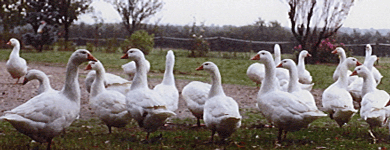
- Its origin is doubtless the same as that of the other white geese of the center of France :
the "Bourbonnais" and the "blanche du Poitou". It is a roasting goose which also provides feathers and
down, and is characterized by its strength, vigor, robustness, fast development and alertness.
It has a yellow-orangy bill, a relatively long and strong neck, and yellow-orangy tarsus ;
the gander weighs 6 to 7 kg , the goose 5 to 6.5 kg. Its standard has never been recorded and a request
for this by the Société avicole de Touraine, was rejected by the French comission of poultry standards
on May the 23rd 1998.
- Top of the page
Grise des Landes
- Grise du Marais poitevin
- Normande
-
Toulouse à bavette and Toulouse sans bavette
- Touraine

L'oie d'Alsace
(Alsatian goose)

L'oie blanche du Bourbonnais (White
Bourbonnais goose)

L'oie de Bresse (Bresse goose) - oie de l'Ain

L'oie Flamande

L'oie grise des Landes (Grey Landes goose)
Top of the page

L'oie grise du Marais poitevin
(Gruse goose of the Poitou marshes)

L'oie Normande (Norman goose)
L'oie blanche du Poitou
(White Poitou goose)
L'oie de Toulouse à bavette (Dewlapped Toulouse goose)


L'oie de Toulouse sans bavette (Toulouse goose without dewlap)
L'oie de Touraine (Touraine goose)
